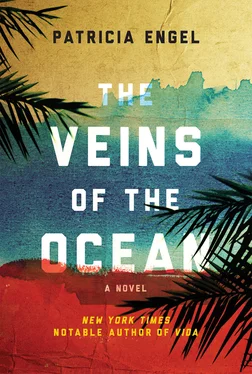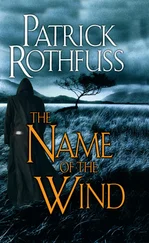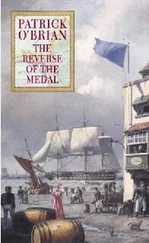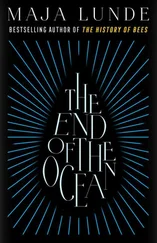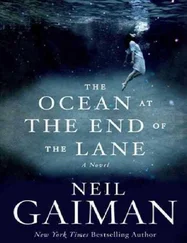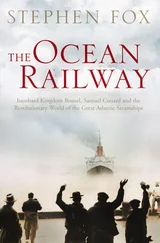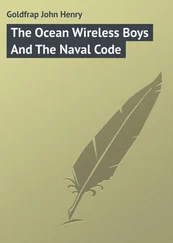“Got it.”
I don’t tell him there are no fences out there marking where the oceans end and the seas begin. It’s the same water flowing free. I read in one of the cottage magazines that a single wave can travel around the whole world before it hits shore. There are no borders, no security checkpoints to inhibit a wave’s journey. The world’s oceans are one body of life. Only land separates water, but land, too, is rooted in the ocean.
I don’t tell him that a few nights ago, as we sat together watching a storm from the cottage veranda, lightning filling the sky like arteries over distant columns of rain, Nesto told me Yemayá’s realm in the ocean is the greatest energy conductor, able to absorb the temperature of Changó’s lightning strikes, each one hotter than the sun.
“It’s power beyond our understanding,” Nesto said.
Then he added that the only things we can count as truth are two prophecies of the diloggún that rest against each other:
No one knows what lies at the bottom of the ocean.
And the next prophecy:
Blood that flows through the veins.
It’s a simple plan. Nesto is slotted by the agency for a flight to Havana next weekend. We have to do it quickly or risk having to wait until he returns.
We know we are breaking laws starting with trespassing and vandalism.
We have a cloudy moonless night and a cold rainstorm on our side, though without wind, thunderclaps, or lightning.
This, Nesto reassures me, means that Olódumare, the Creator, owner of the world’s secrets, who pours rain, is offering us cover.
We’ve had Lolo’s boat for a few days after taking it out for some dives. During this time, Nesto and I practiced, running it slowly down the canal along Hammerhead, each of us suited up and jumping off, to time how long we thought it would take to undo all the clamps on two poles, for both of us to pull the sheet of fence fabric down into the sand and clear the way for the dolphin to come out. It was faster than having to cut a hole with pliers, a bolt cutter, and a saw. We’ll have our wetsuits, fins, masks, and gloves, because Nesto knows the fence is already scabbed with sharp barnacles. We won’t take oxygen though, because we know the noise and bubbles would probably make the dolphin even more apprehensive.
The night we go out, we do ventilation patterns to open our lungs, to oxygenate, and to relax our bodies. I’ve looked forward to this night, imagining the dolphin swimming out of the pen and away from us. But the journey from our dock, around the island, under the bridge to the gulf side of the Keys, feels especially long. Nesto promises that with our lights off and rain muffling the sound of the boat’s engine, we won’t be noticed by anyone onshore.
We’ve rehearsed aloud many times. Nesto made drawings of what the fence looks like underwater so I could memorize it because we can’t use a big flashlight and risk attracting attention. We know there is only one security guard on duty at the dolphinarium at night. We’re banking on him tiring of his rounds by three in the morning, taking shelter from the rain under one of the canopies at the front of the facility.
As we get closer to the pen, Nesto and I try not to speak to each other. In the darkness, we rely on the silhouettes of hand gestures, touching each other, or whispering deep into each other’s ears if we have to be heard. He stops the boat about twenty meters from the pen and I lower myself into the water, cold seeping through my wetsuit. I slip my mask over my face, and as I fear, I see only blackness. We’ll have to use the tiny flashlights we’ve brought with us that only illuminate the span of a hand. I swim ahead, feeling for the fence, setting my intentions in my mind the way Nesto taught me to do whenever we approach the ocean for a dive. And because Jojo told me he learned dolphins can sense our motives, we have to make it clear to them, articulate it to ourselves so they can read it in our being, that we mean no harm.
It’s a matter of minutes, my breath shortening the more I try to push it longer, and I struggle to keep myself from gasping loudly every time I come up for air. I work on one pole, the tiny lights guiding us through the unscrewing of bolts and clamps, cutting the fence ties with the wire cutter while Nesto works on the other, but he finishes before me and slides over to finish my part of the job. The fence begins to wobble and falls over us. Nesto warned me we’d have to back up quickly to pull it down from the top or it could pin us under.
We’ve prepared for this in his drawings and I do as I was instructed until the fence hits the sand at our feet. I swim over to the dolphin, still in the same spot she claimed when the fence was up. I go to her, hoping she’ll smell me or see me or sense me with her sonar the way she did that first day I went into the water with her. I fear she won’t recognize me in this darkness like she did before, or she won’t follow me. But then she starts moving and I do, too, while Nesto clears out of the way and heads back to the boat.
I swim away from the fence slowly, looking back to make sure she’s behind me. In the night I can only see the occasional gloss of her dorsal, feel the water moving around me. But then I feel the pressure of her slipstream and know she’s beside me and I swim a little faster, careful not to kick up water with my fins. We push farther out, past the boat, toward the small mangrove islands dotting the bay until it unfolds into the gulf. She doesn’t touch me, but I feel her through the water, her weight moving against the current, and then, when we are so far out that my body starts to feel much heavier, my breath even shorter, I have to let her go.
I turn, make my way back to the boat, trusting she won’t come back with me, refusing to look behind me so she won’t think to follow. I feel something near my legs and hope it isn’t the dolphin. When I come to the back of the boat, I give Nesto my fins and he reaches out his arms to lift me in.
We don’t speak. We don’t say a word. He starts the boat and we head back for the cottage.
It’s only later when we stand on the bathroom tile and peel out of our wetsuits that we each take in the stunned look on the other’s face.
I am certain we’ve done the right thing, but we can’t know until the morning if we’ve been successful. For now, we have to wait.
I don’t know what to say to him, how to thank him for helping me do what I asked. I reach my arms around him and put my face against his chest. We don’t shower off. Tonight, we go to bed as we are, sticky, salty with the sea.
By the time we get to work the next morning, the dolphinarium is erupting with scandal. Mo’s been calling Nesto for more than an hour already, telling him to hurry up and come in to work though he won’t say why. A local news van is parked out front, along with several police cars. The employees, from the gift shop ladies to the maintenance workers to the trainers and vets, are in disbelief. Nesto and I approach the crowd at the end of the walkway, where the curtain stood, though it’s been removed. Charlie, one of the techs, tells us the fence collapsed and the dolphin escaped out of the pen. Rachel and some of the other staff members are already out on the boats trying to find her, so far with no luck.
Mo, the park owners, and the cops take Nesto aside, since he was the one to erect the fence and was in charge of making sure it was sound. I watch as they question him for their police and incident reports, asking him to explain the exact procedures he used to build and check the fence. Nesto tells them on his last check the fence was in perfect condition, not a screw out of place.
Soon, Mo tells everyone to get back to work. He says he’s sure it wasn’t an accident that the fence collapsed; it’s too unlikely all the hinges would come undone at the same time and it would fall uniformly to the ground. That’s how he knows it was a deliberate breakout and not that the rain or winds pulled the fence open, or that the dolphin pushed the fence down herself.
Читать дальше
